All the ways I failed miserably trying to live plastic-free for a week

- Share via
Near the end of a May trip to Portugal last year, my wife, Pam, picked up a paperback at a bookshop in Lisbon — “How to Give Up Plastic: Simple Steps to Living Consciously on Our Blue Planet.” The cover illustration was a cartoon sperm whale blasting a cloud of bottles and utensils from its blowhole.
“Some light plane reading?” I said.
I didn’t expect much of a laugh from that, nor did I expect the book to inspire a dramatic, if brief, lifestyle change.
I was wrong. The book, by Greenpeace U.K.’s head of oceans, Will McCallum, told an ecological horror story about seas choked with plastic straws and single-use grocery bags. It also offered the “simple steps” of how to eliminate plastic items from your office space, kitchen and bathroom. I’d never considered buying toothpaste without a plastic tube. Now it felt like a moral imperative.
Back home in Silver Lake, we experimented with going plastic-free for about six weeks. How hard could it be, right? This is central Los Angeles, where plastic straws rank with cigarette butts as a social taboo.
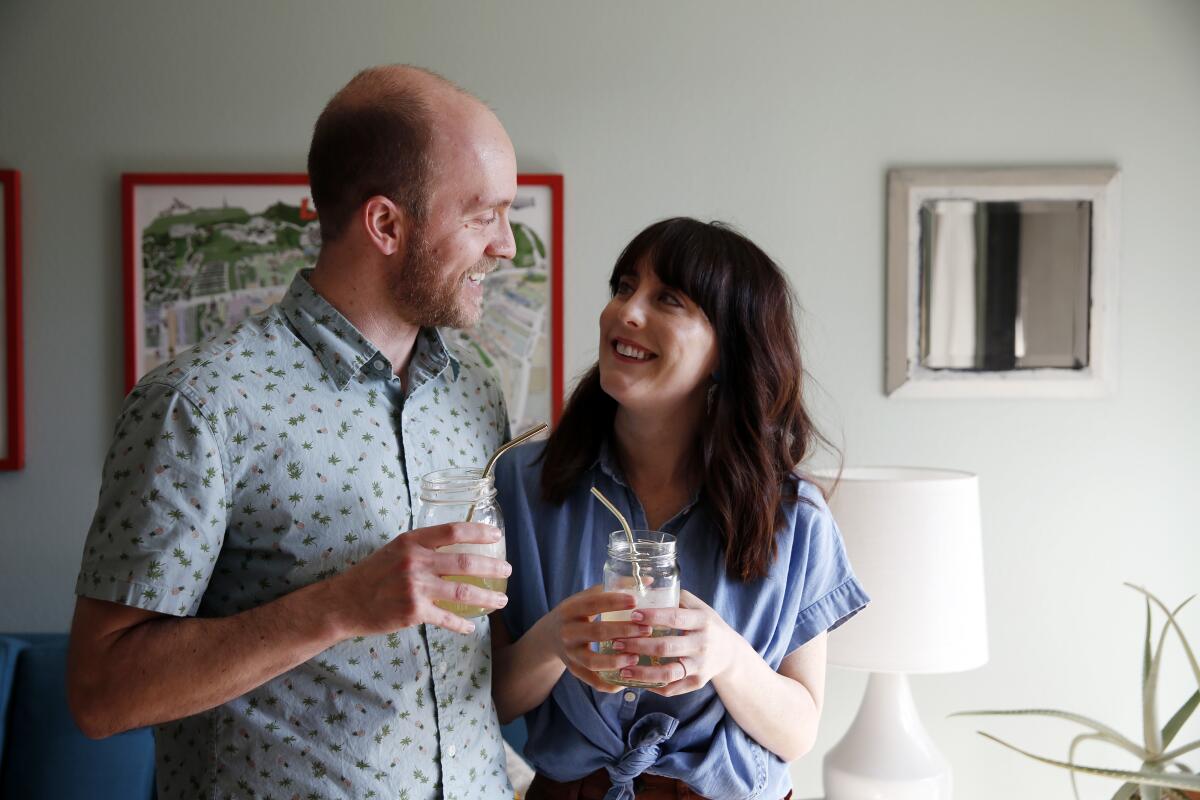
We ultimately failed. Plastic stuff slowly found its way back into our daily lives, even as we continued to go without meal kit services and plastic water bottles. After a long workday, commute and gym visit, the appeal of Thai delivery overwhelmed the guilt of basically becoming a “Captain Planet” villain.
But recently, I wanted to try again. I wanted to see if I could learn from past errors and do better. Here’s how that went.
Day 1
My first step was to take inventory of our kitchen.
Going plastic-free takes more than a set of metal straws and vacuum-insulated portable coffee mugs, but we had those on hand, and it was a start. I also had various airtight glass food containers, Mason jars and leftover plastic takeout boxes. I spent an hour organizing, because if I didn’t, I knew I’d fall back on zipper storage bags.
I stuffed a canvas tote with the urban plastic-free essentials: a 20-ounce Yeti tumbler, a straw, a dog bowl and a fork.
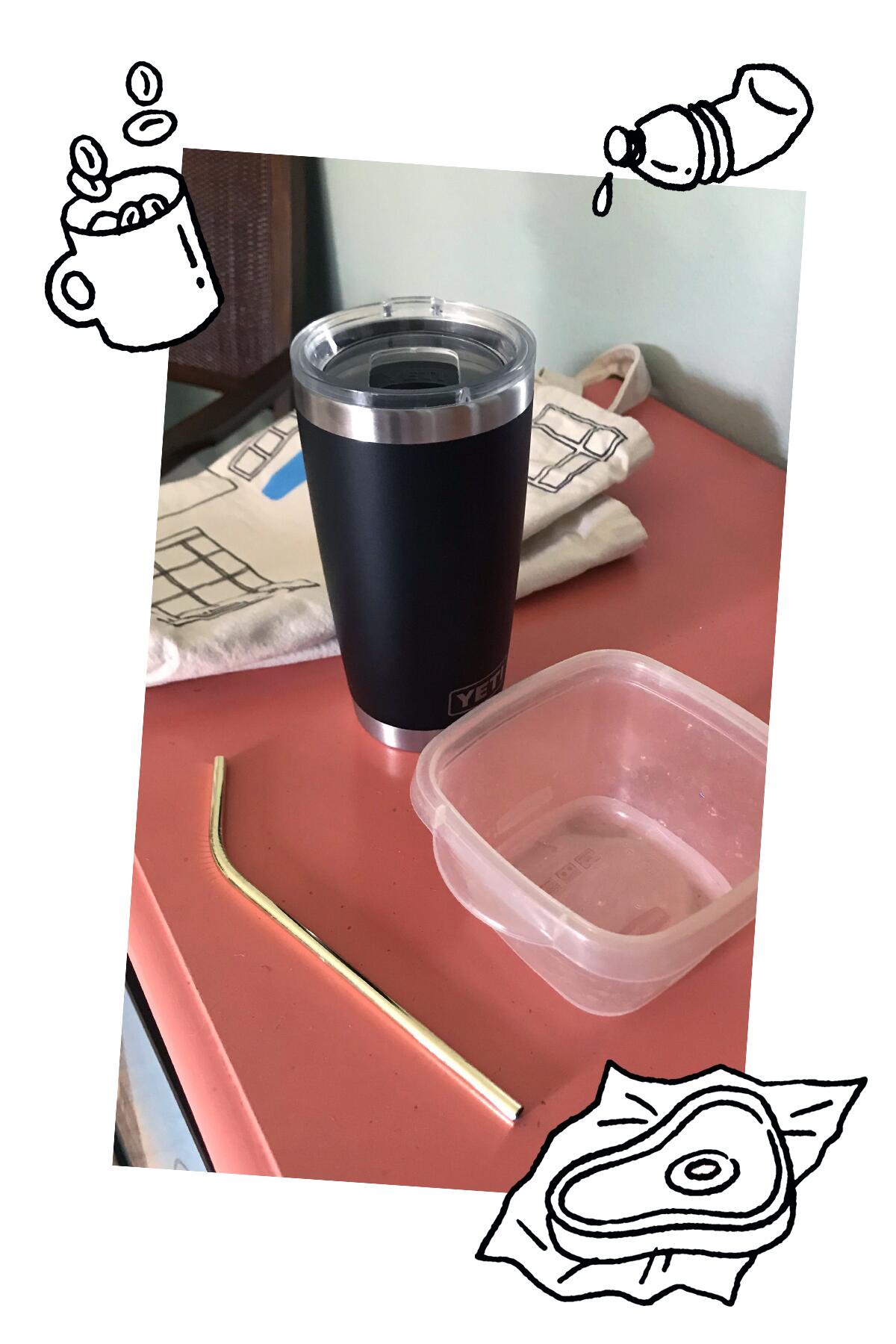
First stop was Jeni’s on Hillhurst Avenue for ice cream. The eatery has metal spoons typically reserved for giving flavor samples, but we knew from experience that employees will let you use them for a full bowl. Most shops are happy to oblige your weird plastic-avoidance requests as long as you explain yourself. “I’ll bring it back; I’m just trying to not use plastic,” Pam told the Jeni’s server. That was good enough for the employee. Or you could go with my method and use a cone.

Later, we stopped by the Americana at Brand in Glendale for some shopping. It was eye-opening to what extent the plastic-free trend had reached mass-production levels. Anthropologie sells an assortment of products marketed as “plastic-free,” including Stasher silicone storage bags, Byta water bottles and 8-ounce Huskee coffee cups. And yet, across the street at Banana Republic, boxer briefs are sold individually wrapped in plastic bags.
American capitalism, welcome to the green revolution.
Day 2
I rushed to the Atwater Village farmers market Sunday afternoon, almost forgetting my largest Mason jar, knowing this was my last chance to find plastic-free berries before the workweek. Strawberries, raspberries and blackberries are almost always packaged in plastic at regular grocery stores.
Skip the single-use plastic bags in your lunchbox. Here’s a DIY for making your own reusable beeswax food wraps.
Even at farmers markets, strawberries come in green plastic trays. So after paying the young woman at the register, I dumped the berries into the jar and returned the unneeded plastic.
The glassware I brought was big enough for only half the berries, leaving the rest to roll around loose in my tote. I laughed at my rookie mistake as regulars milled effortlessly through the rows of greens filling reusable cloth mesh bags with watercress and kale.

We needed to stock up on household supplies, so Pam and I visited Highland Park’s Sustain L.A., a boutique that sells products for “zero-waste” enthusiasts. An energetic employee gave us the rundown, explaining how to navigate the store’s giant glass jars of intimidatingly similar-looking fluids, including bubble bath, all-purpose cleaner and laundry liquid. Don’t want to confuse those.
The layout, similar to that at No Tox Life in Glassell Park and the Refill Shoppe in Ventura, was less daunting than the prices. I filled a 2-ounce glass jar with deodorant paste from a larger glass jar and paid $15 for the privilege. Use sparingly, for the environment and your wallet.
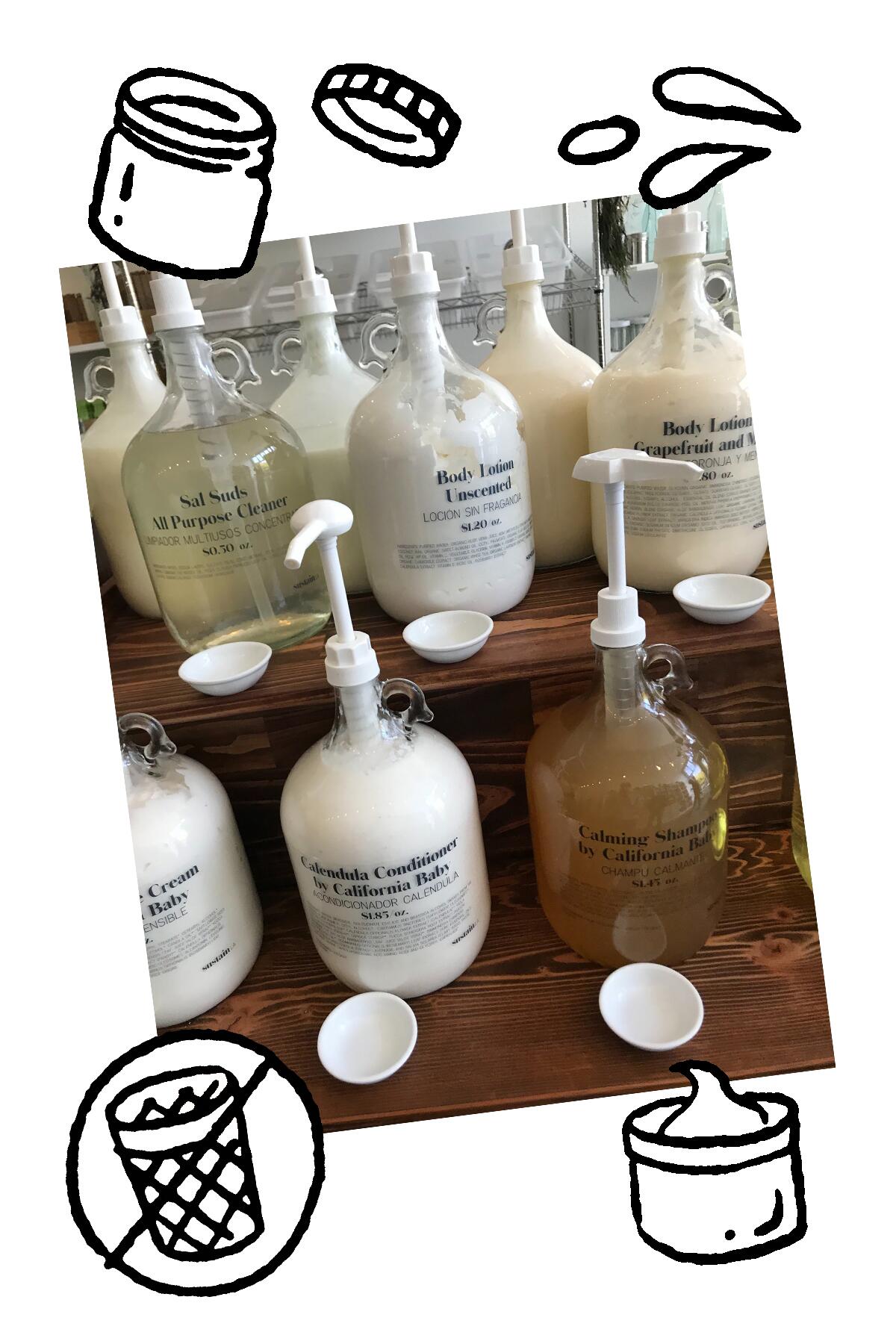
Day 3
My Monday challenge was to cook a favorite dinner recipe (Alison Roman’s pork and red chile stew). McCallum recommends shopping at local grocers because they tend to sell loose produce and bulk items, unlike chain supermarkets that depend heavily on plastic wrapping. I’m looking at you, Trader Joe’s.
I tested this at a couple of food markets on Virgil, armed with new cloth mesh bags for the veggies. Tomatillos, New Mexico chiles and radishes were easy to find without packaging. Tortillas, on the other hand, seem to come only in plastic wrapping. If you want tortillas plastic-free, make them at home.
Finding pork shoulder was my downfall. At some markets, I’ve been able to request meat wrapped in butcher paper without plastic, but not at the local carnicería. I briefly considered what it would be like to carry 2.5 pounds of loose red meat in a canvas tote. Probably not a good idea. I took the loss on this one and ended up with a fistful of useless plastic.
Day 4
Waking up Tuesday, I realized I forgot to buy coffee, necessitating an after-work trip to the Eagle Rock Sprouts, one of the mainstream chains with bulk bins. (Another is the aggressively fancy Erewhon Market.) To avoid using the plastic produce bags Sprouts provides, we brought old takeout soup containers, which a clerk weighed before we went to the coffee aisle. Along with the coffee beans and bulk bins of flour and quinoa, we found a plastic-free roll of dental floss (yes, this exists, and it’s great).
What’s more, Sprouts’ meat counter uses paper, so I ordered two cuts of salmon, thinking I was really getting the hang of this minimal waste thing. My feeling of accomplishment sank when Pam unwrapped the fish and looked at the paper.
“Uh-oh, this might be lined with plastic,” she said.
True, it did look kind of shiny. In a lightly paranoid panic, I called and emailed Sprouts customer support, which got back to me days later. It turned out Sprouts uses wax- and oil-coated paper, which is not recyclable but which can go in a compost bin. I considered this a partial victory.
Day 5
Many products use plastic in ways that are not obvious. One might assume that paper coffee cups are more environmentally friendly than their clear cold-drink counterparts. I’ve occasionally ordered a hot coffee at Starbucks and left the plastic lid on the counter. You’re welcome, Earth!
Alas, this does little good. Only a small percentage of paper cups get recycled. Most coffee cups are lined with plastic to make them waterproof. To be recycled, the paper must be separated from the plastic part, something recycling centers generally don’t do.
This became an issue after a Wednesday work lunch in Beverly Hills, when I was craving a caffeine jolt. The aroma from the nearby coffee shop was like a tractor beam, but I’d forgotten my reusable mug at home. (Using refillable mugs has become more complicated with the coronavirus outbreak; Starbucks this week temporarily stopped accepting them.) I made it back to the L.A. Times office, miraculously, both caffeine- and plastic-free, ready to make a deadline, more or less.
Day 6
One of the challenges that tripped me up last year was finding lunch options near the office.
Food spots near the L.A. Times’ El Segundo office are limited, so I developed a thorough knowledge of where I could go with little effort, and where I’d have to bring my own fork. Yelp, alas, does not have a plastic-free filter.
Takeout is generally anathema to the waste-conscious consumer, and delivery services can be even worse, serving up plastic utensil bundles and plastic containers, sometimes all wrapped in a plastic bag. I’ve tried putting notes to the delivery folks in the Caviar app asking them to avoid plastic, but those messages are either missed or ignored.
The cafeteria across the street is a solid option for those with time to dine in. The nearby Mediterranean cafe is decent, but it uses plastic utensils, like most fast-casual establishments. My preference is the strip-mall pizza joint Il Romanista, which serves its slices on wooden trays and a sheet of paper to catch the oil. Yes, plastic utensils are available, but come on, it’s pizza. Just use your hands.
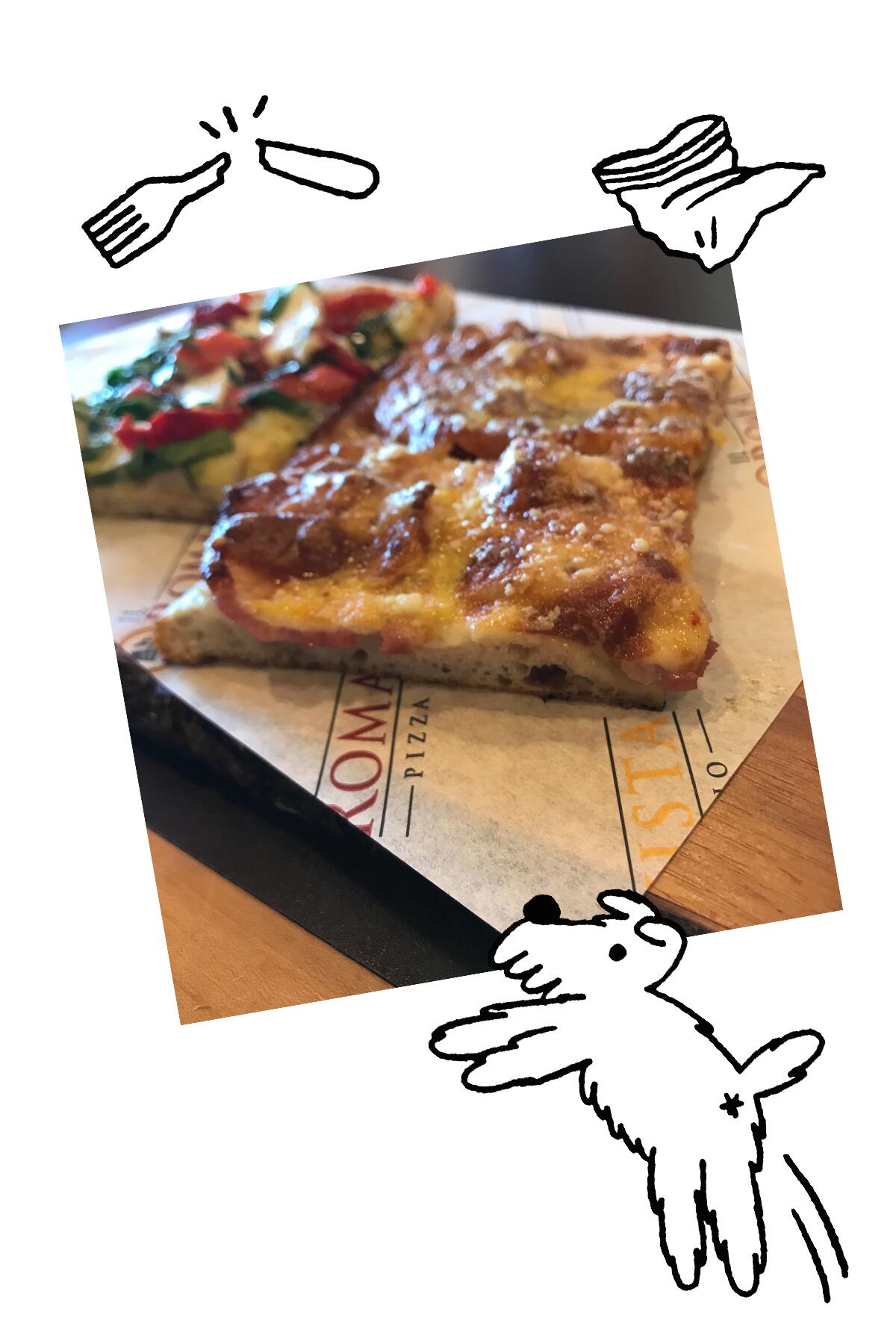
Pam’s strategy is to get meals from her nearby Lemonade by ordering food to go, but on a paper plate. This draws deeply perplexed looks from servers, unless she explains the reason for the request.
Day 7
After just a few days back in the plastic-free game, I’m struck by how limited these efforts really are. Reducing plastic use feels a little like going pescatarian instead of vegan. But thinking about it regularly reminds me of all the other measures I could take to reduce my planetary impact.
I could cut meat from my diet, replace my clunky commuter car with an electric, or actually get that compost bin. It’s difficult for daily gestures of plastic avoidance to feel meaningful compared to the emissions resulting from just getting around Los Angeles. But McCallum’s point, I think, is that we can all make modest steps that, in totality, could make some difference.
My existential dread gave way to curiosity when I went to the local pet supply store, Echo Bark, to pick up kibble for our tiny dog, Remy.
Don’t get overwhelmed. Start with doable goals in your quest to cut back on plastics.
The plastic-free craze has surprisingly not yet made the jump to the pet owners market. There were no bulk bins of scoopable dry kibble that I could find, even in Los Angeles. However, there are multiple brands of biodegradable dog waste bags, so I may switch to those. What’s more Los Angeles than considering the environmental footprint of your 10-pound mini dachshund?
After momentarily wondering how many people cook their own dog food recipes for the sake of environmental ethics, I compromised by buying in bulk, sort of. Instead of the 4-pound plastic food bag, I grabbed the 10-pound pack of small-breed chow, which I carry under my arm along with a tote bag and a tumbler full of cold brew.
That has to count for something, right?
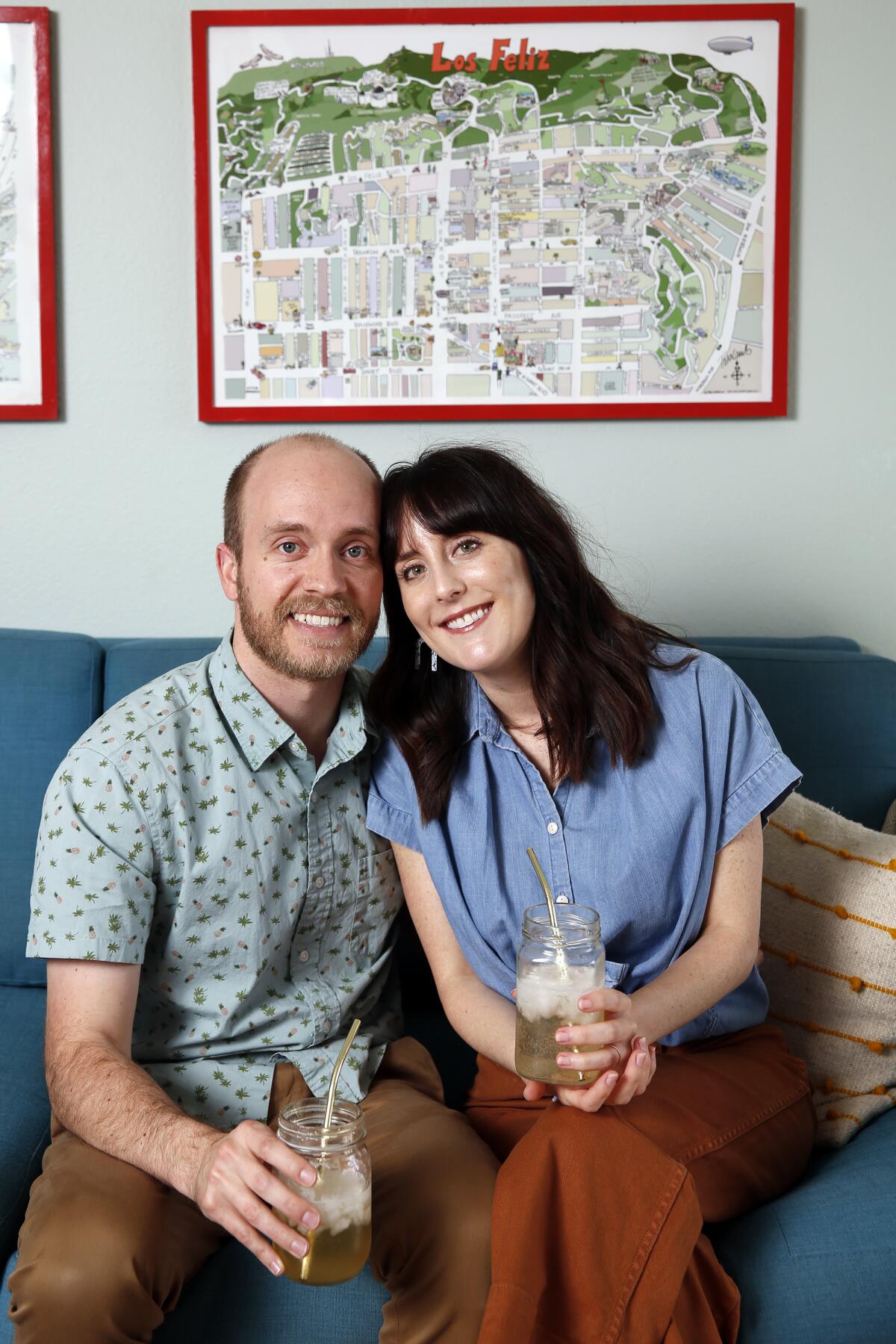
More to Read
Sign up for The Wild
We’ll help you find the best places to hike, bike and run, as well as the perfect silent spots for meditation and yoga.
You may occasionally receive promotional content from the Los Angeles Times.













